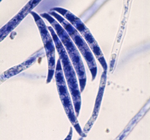
BLOYER Sébastien
- Chromatine Dynamics, Institute for Integrative Biology of the Cell (I2BC) - CNRS - Université Paris Saclay - UMR 9198, Gif-sur-Yvette, France
- Epigenomics
- recommender
Recommendation: 1
Reviews: 0
Recommendation: 1

Nucleosome patterns in four plant pathogenic fungi with contrasted genome structures
Genome-wide chromatin and expression datasets of various pathogenic ascomycetes
Recommended by Sébastien Bloyer and Romain Koszul based on reviews by Ricardo C. Rodríguez de la Vega and 1 anonymous reviewerPlant pathogenic fungi represent serious economic threats. These organisms are rapidly adaptable, with plastic genomes containing many variable regions and evolving rapidly. It is, therefore, useful to characterize their genetic regulation in order to improve their control. One of the steps to do this is to obtain omics data that link their DNA structure and gene expression.
In this paper, Clairet et al. (2022) studied the nucleosome positioning and gene expression of four plant pathogenic ascomycete species (Leptosphaeria maculans, Leptosphaeria maculans 'lepidii', Fusarium graminearum, Botrytis cinerea). The genomes of these species contain different compositions of transposable elements (from 4 to 30%), and present an equally variable compartmentalization. The authors established MNAse-seq and RNA-seq maps of these genomes in axenic cultures. Thanks to an ad-hoc tool allowing the visualization of MNA-seq data in combination with other "omics" data, they were able to compare the maps of the different species between them and to study different types of correlation. This tool, called MSTS for "MNase-Seq Tool Suite", allows for example to perform limited analyses on certain genetic subsets in an ergonomic way.
In the fungi studied, nucleosomes are positioned every 161 to 172 bp, with intra-genome variations such as AT-rich regions but, surprisingly, particularly dense nucleosomes in the Lmb genome. The authors discuss the differences between these organisms with respect to this nucleosome density, the expression profile, and the structure and transposon composition of the different genomes. These data and insights thus represent interesting resources for researchers interested in the evolution of ascomycete genomes and their adaptation. For this, and for the development of the MSTS tool, we recommend this preprint.
References
Clairet C, Lapalu N, Simon A, Soyer JL, Viaud M, Zehraoui E, Dalmais B, Fudal I, Ponts N (2022) Nucleosome patterns in four plant pathogenic fungi with contrasted genome structures. bioRxiv, 2021.04.16.439968, ver. 4 peer-reviewed and recommended by Peer Community in Genomics. https://doi.org/10.1101/2021.04.16.439968